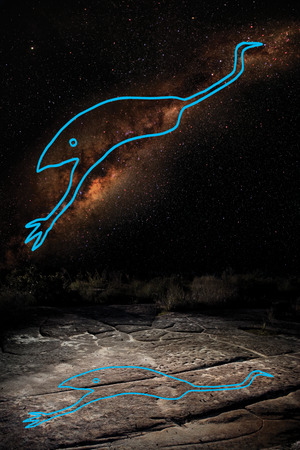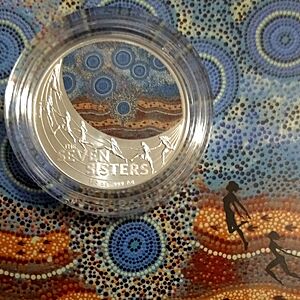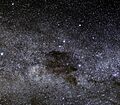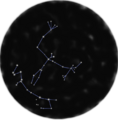Australian Aboriginal astronomy facts for kids

Australian Aboriginal astronomy is the knowledge of the stars, planets, and sky held by the Indigenous peoples of Australia. This knowledge was passed down for thousands of years through stories, ceremonies, and art. It shows a deep understanding of how objects in the sky move. This allowed them to create calendars and navigate across the vast land and waters of Australia. Because their astronomical knowledge is so ancient, Aboriginal peoples are often called the "world's first astronomers".
Many Aboriginal constellations are groups of stars, just like in Western astronomy. These include their versions of the Pleiades and Orion. But some constellations are unique, like the famous 'Emu in the Sky'. This shape is made from the dark patches in the Milky Way, not the stars. Modern Aboriginal art often features these star stories, especially the tale of the Seven Sisters.
Contents
Records of Aboriginal Astronomy
One of the first people to write down Aboriginal star knowledge was an Englishman named William Edward Stanbridge. He moved to Australia in 1841 and became friends with the local Boorong people, who shared their knowledge with him.
Stories in the Stars
Aboriginal cultures across Australia have many stories about the objects they see in the night sky. These stories often teach important lessons about life, law, and nature.
Emu in the Sky

One of the most famous Aboriginal constellations is the "Emu in the Sky". It is not made of stars, but of the dark clouds of dust and gas, called dark nebulae, that stretch across the Milky Way. The Emu's head is a very dark patch known as the Coalsack Nebula, which is right next to the Southern Cross. Its body and legs are formed by other dark areas that reach towards the constellation Scorpius.
In Ku-ring-gai Chase National Park, north of Sydney, there are ancient rock engravings made by the Guringai people. One engraving shows an emu in the same position as the Emu in the Sky constellation.
In May 2020, the Royal Australian Mint released a special one-dollar coin to celebrate the Emu in the Sky as part of its "Star Dreaming" series.
Canoe in Orion
To the Yolŋu people of northern Australia, the constellation Orion is a canoe called Julpan. Their story tells of three brothers who went fishing. One brother ate a fish that was forbidden by their laws. The Sun-woman, Walu, saw this and created a waterspout that lifted the brothers and their canoe into the sky.
The three stars of Orion's Belt are the three brothers. The Orion Nebula is the forbidden fish, and the bright stars Betelgeuse and Rigel are the front and back of the canoe. This story was a reminder of the importance of following community rules.
The Seven Sisters
The story of the Seven Sisters, a star cluster known in Western astronomy as the Pleiades, is one of the most widespread stories in Aboriginal Australia. It is a Dreaming story told across the continent.
The story is about seven sisters who are chased by a man (often represented by stars in Orion). The sisters travel across the land to escape him, and their journey creates many features of the landscape. Finally, they travel up into the sky to become the star cluster we see today.
- Art and Culture: The Seven Sisters story is a very popular subject in Aboriginal art. The Tjanpi Desert Weavers, a group of female artists, created a large art piece showing the story. It was displayed at the National Gallery of Australia.
- Different Versions: In the Kimberley region, an eagle hawk chases the sisters into the sky. He becomes the Southern Cross.
- The Karatgurk: The Boonwurrung people of Victoria tell a story of how the seven sisters held the secret of fire. A crow stole the secret from them and gave it to people on Earth.
In 2017, the National Museum of Australia created a major exhibition called Songlines: Tracking the Seven Sisters to share this important story.
The Milky Way
The Kaurna people of the Adelaide Plains call the Milky Way wodliparri, which means "house river". They believed that the River Torrens on Earth was a reflection of this great river in the sky.
The Yolŋu people believe that when a person passes away, their spirit is carried in a canoe called Larrpan to an island in the sky. The campfires of the spirits can be seen burning along the edge of the Milky Way. A shooting star is the canoe returning to Earth, letting the family know their loved one arrived safely.
Sun and Moon
Many Aboriginal stories describe the Sun as a woman and the Moon as a man.
The Yolŋu say that Walu, the Sun-woman, paints herself with red ochre each morning. Some of the ochre spills on the clouds, creating the sunrise. She then carries a torch across the sky. At the end of the day, she puts out her torch and travels underground to return to the east.
A story about Ngalindi, the Moon-man, explains the phases of the moon. He starts out young and thin (the waxing Moon), but grows fat (the full Moon). His wives became angry with him for being lazy. As they argued, he began to get smaller and smaller (the waning Moon). He tried to escape by climbing a tall tree, but he disappeared completely (the new Moon). After three days, he rises again to repeat the cycle.
Eclipses
The Warlpiri people have a story that a solar eclipse happens when the Moon-man passes in front of the Sun-woman, covering her for a short time. This belief is shared by other groups, such as the Wirangu.
Venus and Jupiter
The rising of Venus is very important for the Yolŋu people. They call it Barnumbirr, the Morning Star. They believe it creates a rope of light that connects Earth to the spirit island of Baralku. This allows them to communicate with loved ones who have passed away.
The Dja Dja Wurrung people call the planet Jupiter "Bunjil's campfire". Bunjil is their creator spirit.
A Star's Great Outburst
In the 1840s, a star called Eta Carinae suddenly became very bright in the sky. In 2010, astronomers realized that the Boorong people of Victoria had seen this event. They made it part of their stories, calling the newly bright star Collowgulloric War. This is the only known record of this star's outburst from an Indigenous culture.
Using Stars as a Calendar
Aboriginal calendars are often different from the calendars used today. Many groups in northern Australia have six seasons, and they use the stars to know when each season begins.
The rising and setting of certain stars told Aboriginal people when it was time to find different foods or move to a new place. These star calendars were very important for survival.
- The Boorong people of Victoria knew that when the constellation Lyra (which they saw as a Malleefowl) disappeared in October, it was time to gather the bird's eggs.
- When Orion first appeared in the sky, people knew that dingo puppies were about to be born.
Some ancient stone arrangements, like Wurdi Youang in Victoria, may have been used to track the sun's movement and mark the solstices and equinoxes.
Astronomy in Modern Culture
Many modern Aboriginal artists use astronomical themes in their work. They paint the star stories from their cultures, keeping the ancient knowledge alive. Artists like Gulumbu Yunupingu and Bill Yidumduma Harney have won awards for their art that features the stars.
The daughters of the famous artist Clifford Possum Tjapaltjarri also paint the Seven Sisters Dreaming. They inherited this important story from their mother's side of the family. This shows how these traditions continue to be passed down through generations.
Images for kids
-
The "Emu in the sky" constellation. The head of the emu is the Coalsack.
-
The Greek myth of the Pleiades is similar to Australian Aboriginal legends. In both, the seven stars are young women chased by a man in the Orion stars.
-
The constellation of Tagai, important to Torres Strait Islanders.
See also
 In Spanish: Astronomía aborigen australiana para niños
In Spanish: Astronomía aborigen australiana para niños
- Australian Aboriginal Astronomy Project
- Archaeoastronomy
- Indigenous Australian art
- List of archaeoastronomical sites by country
- Pleiades in folklore and literature





